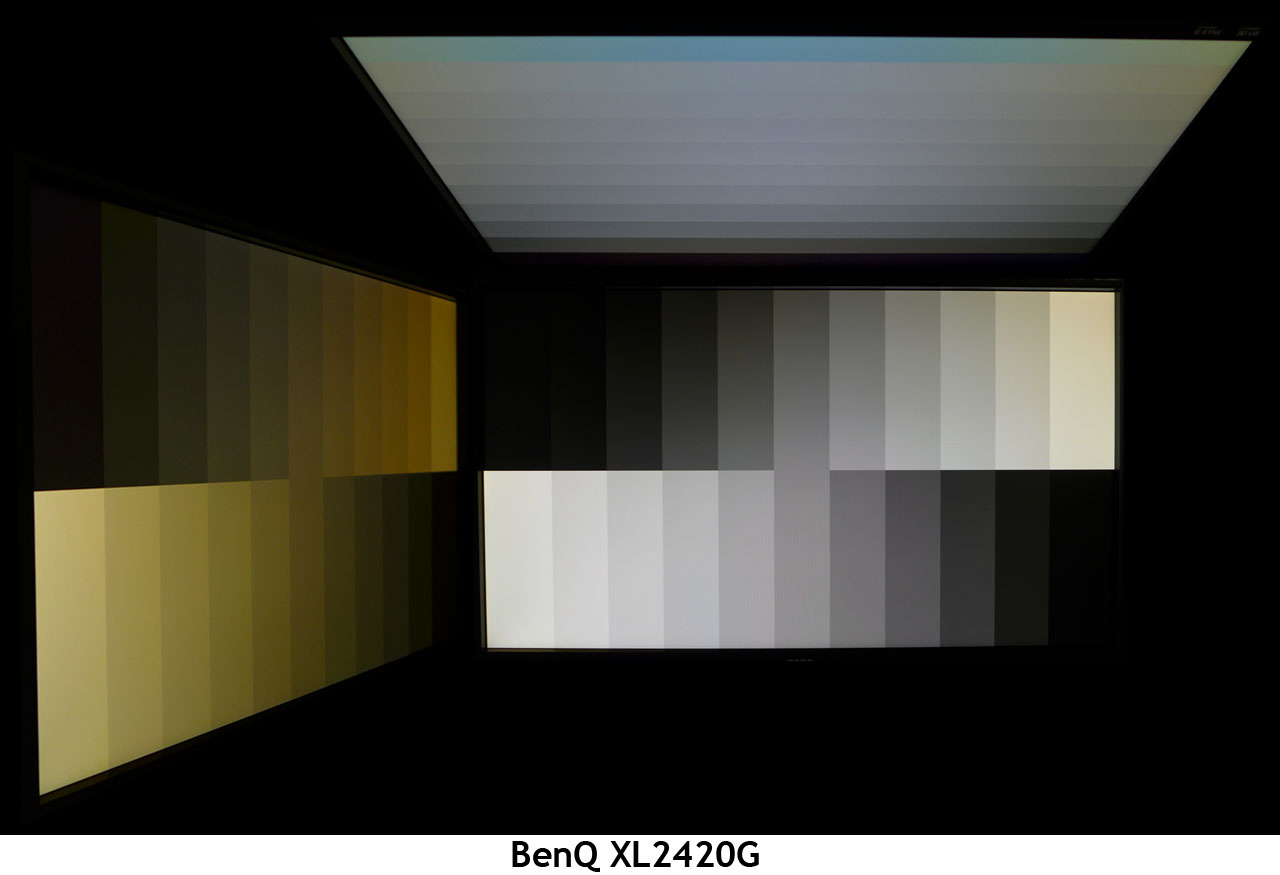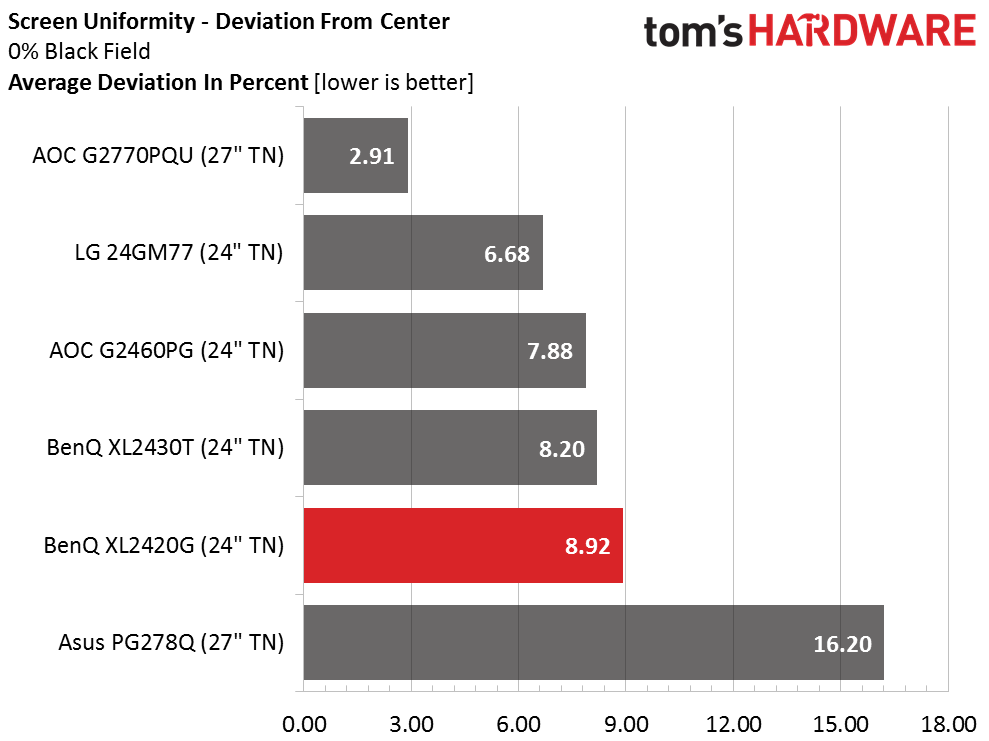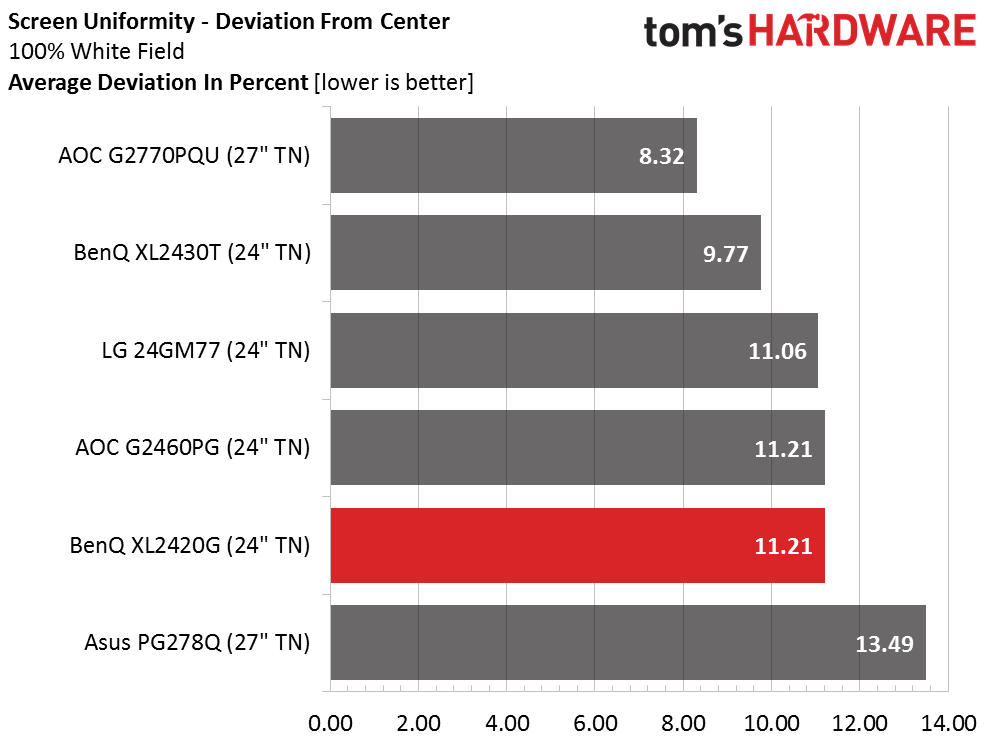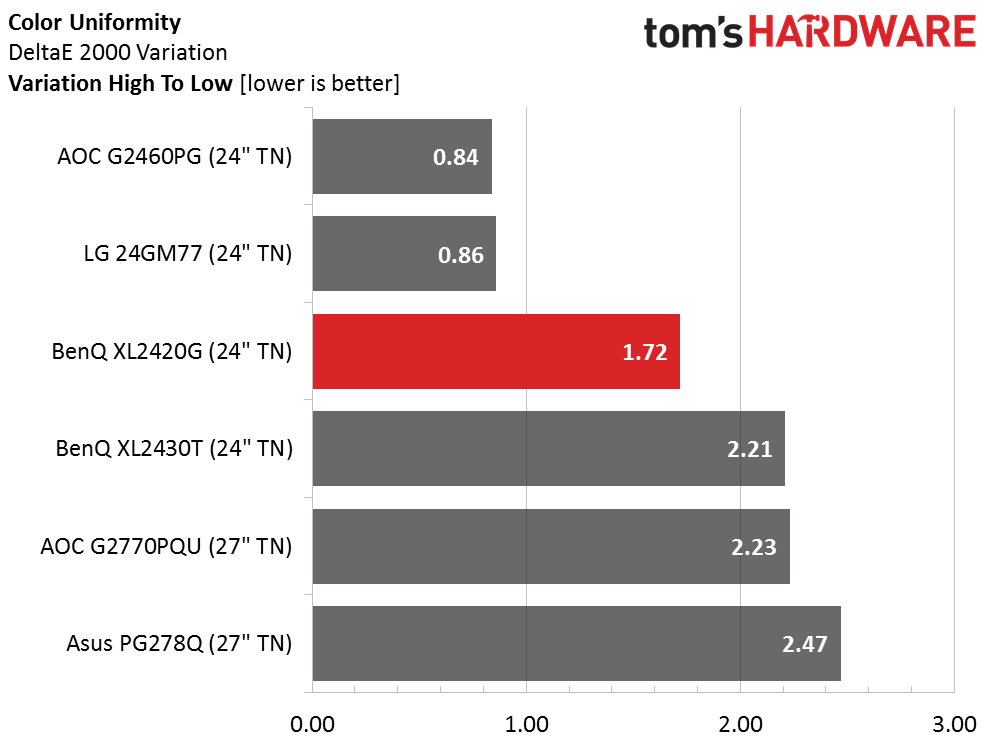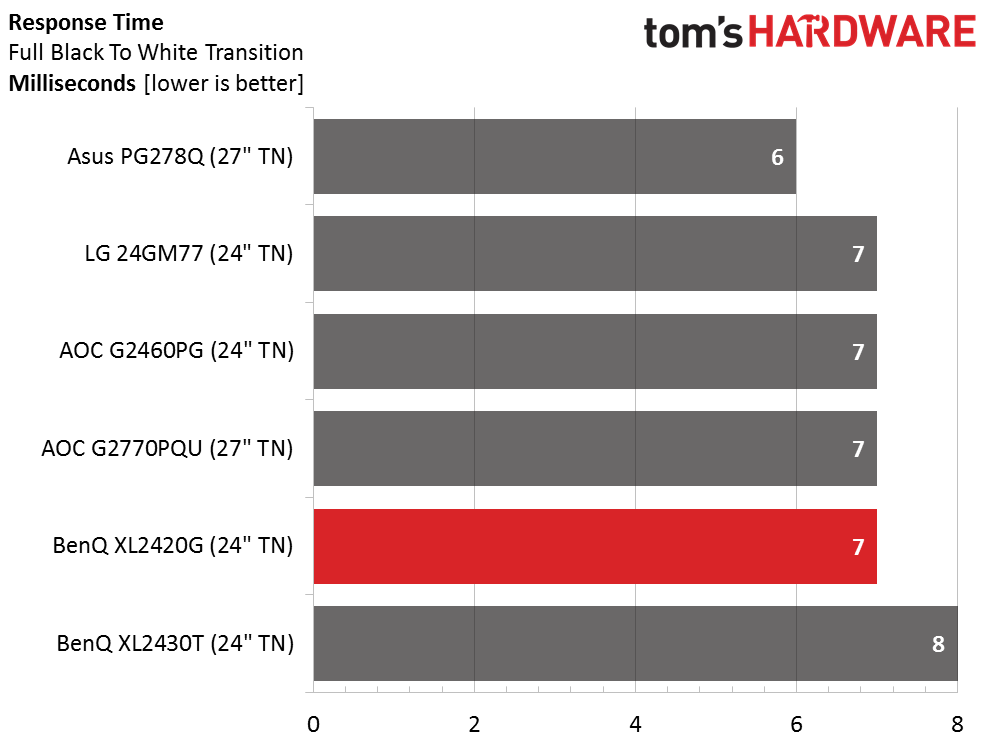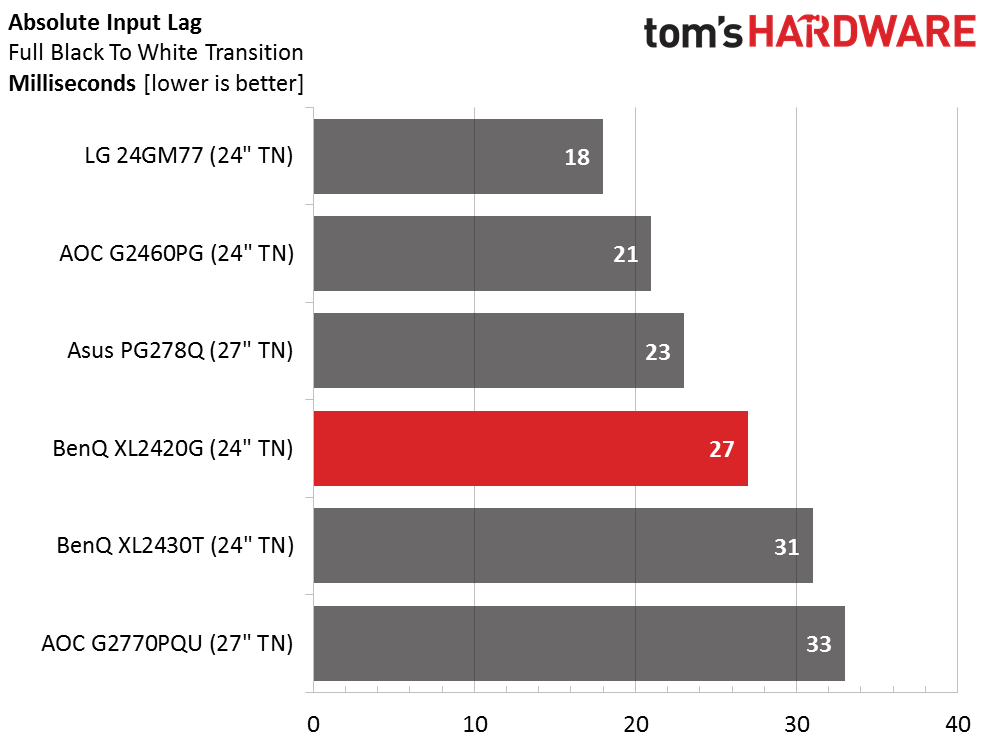BenQ XL2420G G-Sync Monitor Review
Even though FreeSync is starting to appear, G-Sync is still the go-to tech for gamers seeking an image free of frame-tearing. Today we’re checking out BenQ’s latest feature-laden display – the 24-inch XL2420G.
Why you can trust Tom's Hardware
Viewing Angles, Uniformity, Response And Lag
To learn how we measure screen uniformity, please click here.
Like many enthusiasts, we long for more IPS- and VA-based options, especially in the gaming category. For now, however, fast refresh models are dominated by TN panel technology. Our photos of the XL2420G show typical red/green shift and light falloff to the sides, and a severe loss of detail as the gamma shifts in the vertical plane.
Screen Uniformity: Luminance
The XL2420G turns in solid performance in our black field test. Any result under 10 percent means you won’t see light bleed with your naked eye. Still, our instruments show a slight hot spot in the center of the screen.
Here’s the white field measurement:
The white field result is almost as good, aside from the same hot spot in the center. Additionally, our C6 meter reports a little less brightness in the top third of the panel. Again, this is not visible to the naked eye.
Screen Uniformity: Color
A 1.72dE variation is extremely small. As with the luminance tests above, you won’t see any issues; just a smooth white tone from one edge to the other. TN-based panels have come a long way in the last two years. They now fall behind IPS only in off-axis image quality. Color and uniformity are pretty much comparable between the two technologies.
Pixel Response And Input Lag
To perform these tests, we use a high-speed camera that shoots at 1000 frames per second. Analyzing the video frame-by-frame allows us to observe the exact time it takes to go from a zero-percent signal to a 100% white field.
Get Tom's Hardware's best news and in-depth reviews, straight to your inbox.
Testing a 144Hz gaming monitor means we can’t use our AccuPel generator, since it's limited to 60Hz. Instead, we hook the XL2420G up to a GeForce GTX 780-equipped PC and film a mouse movement that triggers the field pattern’s appearance. Since this is less precise than using the generator, we average five measurements. Here’s the screen draw result:
A two-millisecond gap from first to last means these monitors are essentially identical in their screen response. Even though you can reduce motion blur with the XL’s built-in backlight strobe, it’s barely necessary. And you’ll lose 65 percent of the available light output.
Here are the lag results:
All of these monitors have imperceptible input lag, so even the last-place AOC G2770PQU enables a responsive gaming experience. The XL2420G lands just below the middle at 27ms, which is perfectly respectable. The only real separator here is whether or not the monitor has G-Sync support, which you’ll pay a premium for. Performance-wise, it’s a wash.
Current page: Viewing Angles, Uniformity, Response And Lag
Prev Page Color Gamut And Performance Next Page Premium Performance At A Premium Price
Christian Eberle is a Contributing Editor for Tom's Hardware US. He's a veteran reviewer of A/V equipment, specializing in monitors. Christian began his obsession with tech when he built his first PC in 1991, a 286 running DOS 3.0 at a blazing 12MHz. In 2006, he undertook training from the Imaging Science Foundation in video calibration and testing and thus started a passion for precise imaging that persists to this day. He is also a professional musician with a degree from the New England Conservatory as a classical bassoonist which he used to good effect as a performer with the West Point Army Band from 1987 to 2013. He enjoys watching movies and listening to high-end audio in his custom-built home theater and can be seen riding trails near his home on a race-ready ICE VTX recumbent trike. Christian enjoys the endless summer in Florida where he lives with his wife and Chihuahua and plays with orchestras around the state.
-
Wisecracker I can understand why the display folks thread lightly, here. This price point is a minefield and miss-mash of tech. This monitor might be a bargain at $300.Reply
Otherwise, $500-$600 is Eyefinity/Surround, HD Projector, 60-inch Plasma TV territory. It's a tough sell for a display port-capable monitor these days in Adaptive/G -Sync, being that we are only moments before the flood.
And, the market is not in the high-end, at least, not for long. It's back where us poor slubs with 'pitiful' $200 gaming cards :lol: need the help.
-
bogda Finally a G-Sync monitor with more inputs than one DP. Now give me 1440p resolution and price below 500 and I will consider it.Reply -
DarkSable Just throwing out there - saying that the brighter the monitor the better is absolutely far from the truth. If you're in an office environment under florescent lighting, then sure, but if you're interested in a gaming computer, it's probably in your room or a den, and, well... brighter is only better if you only game at night, or have every possible light on while you do.Reply
From all the gripes about how the monitor gets so dim, that's actually a HUGE benefit for me - nobody every bothers to test what the minimum brightness a monitor can achieve, and many monitors, especially gaming monitors, fail miserably. I'd much rather have less eye strain than picture-perfect colors when I'm gaming at night. -
PaulBags DP has better bandwidth, so why does the HDMI here have better contrast and colour accuraccy?Reply -
Shankovich Here's that $200 nVidia premium kicking in. Could have made it IPS or 1440p guys come on...Reply -
blakphoenix I'm sorry but there is no way this monitor could be classed as having "professional-level color accuracy". For starters it doesn't even get 100% sRGB, let alone the terrible sub 70% AdobeRGB performance. Is it good enough for games? It may well be. Is it professional level colour? Not even close!Reply -
bystander ReplyJust throwing out there - saying that the brighter the monitor the better is absolutely far from the truth. If you're in an office environment under florescent lighting, then sure, but if you're interested in a gaming computer, it's probably in your room or a den, and, well... brighter is only better if you only game at night, or have every possible light on while you do.
Brightness does have one important use; ULMB. In ULMB, because the backlighting pulses, it causes these monitors to be very dim. Extra brightness helps to counteract this issue, but I do agree, testing the minimum might be useful, as there are some people out there that have to play at nearly the lowest levels due to headaches.
From all the gripes about how the monitor gets so dim, that's actually a HUGE benefit for me - nobody every bothers to test what the minimum brightness a monitor can achieve, and many monitors, especially gaming monitors, fail miserably. I'd much rather have less eye strain than picture-perfect colors when I'm gaming at night. -
TechyInAZ Wow very sweet for a monitor. I would highly consider this monitor if I can afford it. Since I use my computer for both work and play.Reply
However, for that price I'm disappointed it's only 1080P. I hope they come out with a free sync 1440P version that's cheaper than this monitor.
